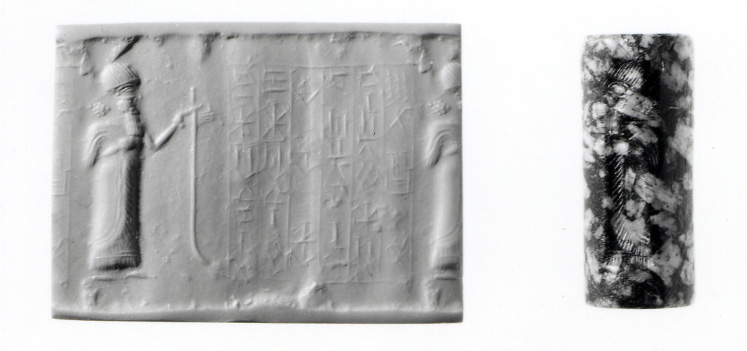Tribal Rulers' Inscriptions
THIS PAGE IS STILL UNDER CONSTRUCTION. PLEASE BE PATIENT WITH US WHILE WE PREPARE THIS CONTENT.
Nabû-šumu-līšir 2001 Marduk-šākin-šumi 2002
2001

MMA 74.51.4426 © The Metropolitan Museum of Art
This inscription is written on a stone weight made of jadeite, measuring 10.7 cm in length, 2.7 cm in thickness at the middle and weighting 164.3 g. The object was acquired by di Cesnola in Cyprus in 1874, probably from an antiquities dealer, even though it is stated by Ward that it was brought by the Wolfe Expedition conducted in Babylonia in 1884-1885. The piece is now preserved in the Metropolitan Museum of Art.
The Akkadian inscription ascribes the property of the object to the palace of Nabû-šumu-līšir, recorded as a member of the tribe of Bīt-Dakkūri and bearing an obscure title that links him with the god Marduk. Although the writing "Palace of PN" was most commonly used for a royal property,
Nabû-šumu-līšir bears no royal title in this inscription neither there is any other indication that could point out his kingship over Babylonia. Nevertheless, on the evidence of the tribal membership stated in the text on the weight, the owner of the object may have been one of the minor Chaldean "kings" in the period between 811 and 770 BC and one of those who paid tribute to the Assyrian king Adad-nārārī III (810-783 BC) in occasion of his campaign against Babylonia.
Access the composite text [http://oracc.museum.upenn.edu/ribo/babylon6/Q006298] of Nabû-šumu-līšir 2001.
>Source
Bibliography
- Frame 1995 [http://oracc.museum.upenn.edu/ribo/babylon6/bibliography/index.html#frame1995], p. 112 (edition)
- Ward 1885 [http://oracc.museum.upenn.edu/ribo/babylon6/bibliography/index.html#ward1885], pp. lvi-lvii (edition)
- Lehmann-Haupt 1891 [http://oracc.museum.upenn.edu/ribo/babylon6/bibliography/index.html#lehmann-haupt1891], pp. 173-174 (edition)
- Lehmann-Haupt 1892 [http://oracc.museum.upenn.edu/ribo/babylon6/bibliography/index.html#lehmann-haupt1892], pp. 95-96 (edition)
- Weißbach 1907 [http://oracc.museum.upenn.edu/ribo/babylon6/bibliography/index.html#weissbach1907], pp. 395-396 no. 8 (edition)
- Brinkman 1968 [http://oracc.museum.upenn.edu/ribo/babylon6/bibliography/index.html#brinkman1968], pp. 215 n. 1338 (edition)
- Ward 1885 [http://oracc.museum.upenn.edu/ribo/babylon6/bibliography/index.html#ward1885], p. lvi (copy)
- Lehmann-Haupt 1891 [http://oracc.museum.upenn.edu/ribo/babylon6/bibliography/index.html#lehmann-haupt1891], pp. 173-174 (copy)
- Myres 1914 [http://oracc.museum.upenn.edu/ribo/babylon6/bibliography/index.html#myres1914], pp. 445, 450, and 556 no. 4426 (photo)
- Weißbach 1907 [http://oracc.museum.upenn.edu/ribo/babylon6/bibliography/index.html#weissbach1907], pp. 395-396 no. 8 (study)
- Myres 1914 [http://oracc.museum.upenn.edu/ribo/babylon6/bibliography/index.html#myres1914], pp. 450 and 556 no. 4426 (study)
- Brinkman 1968 [http://oracc.museum.upenn.edu/ribo/babylon6/bibliography/index.html#brinkman1968], pp. 215-216, 262, and 363-364 no. s (study)
2002

BM 129532 © The Trustees of the British Museum
This inscription is written on a black and white speckled diorite cylinder seal. The piece, measuring 3.35x1.4 cm, is now preserved in the British Museum, but it was previously part of the Tyszkiewicz and Southesk collections.
The seal bears the depiction of a male figure, represented facing the inscription, wearing a cap and a long robe and holding in his left hand a long curved staff.
The Akkadian inscription, written to be read from the seal, states
that the object was gifted to Marduk-šākin-šumi, son of
Marduk-zēra-uballit, descendant of Iakīnu. The tribal parentage makes
it quite possibile that Marduk-šākin-šumi has to be identified with the father of the successive king of Babylonia Erība-Maduk and with one of the minor Chaldean "kings" who paid tribute to the Assyrian king Adad-nārārī III (810-783 BC) in occasion of his campaign against Babylonia.
Access the composite text (no link available) of Marduk-šākin-šumi 2002.
Source
Bibliography
- Pinches in Carnegie 1908 [http://oracc.museum.upenn.edu/ribo/babylon6/bibliography/index.html#southesk1908], pp. 82-83 no. Qβ39 (edition)
- Leemans 1945-1948 [http://oracc.museum.upenn.edu/ribo/babylon6/bibliography/index.html#leemans1945-1948], p. 438 (edition)
- Frame 1995 [http://oracc.museum.upenn.edu/ribo/babylon6/bibliography/index.html#frame1995], p. 113 (edition)
- Carnegie 1908 [http://oracc.museum.upenn.edu/ribo/babylon6/bibliography/index.html#southesk1908], pp. 82-83 and pl. VI no. Qβ39 (photo of impression, copy)
- Collon 1987 [http://oracc.museum.upenn.edu/ribo/babylon6/bibliography/index.html#collon1987], no. 553 (photo of impression)
- Pinches in Carnegie 1908 [http://oracc.museum.upenn.edu/ribo/babylon6/bibliography/index.html#southesk1908], pp. 82-83 no. Qβ39 (study)
- Brinkman 1964 [http://oracc.museum.upenn.edu/ribo/babylon6/bibliography/index.html#brinkman1964], pp. 28-30, esp. nn. 159 and 174 (study)
- Brinkman 1968 [http://oracc.museum.upenn.edu/ribo/babylon6/bibliography/index.html#brinkman1968], pp. 215-216, 262, and 364 t (study)
- Collon 1987 [http://oracc.museum.upenn.edu/ribo/babylon6/bibliography/index.html#collon1987], no. 553 (study)
Giulia Lentini
Giulia Lentini, 'Tribal Rulers' Inscriptions', RIBo, Babylon 6: The Inscriptions of the Period of the Uncertain Dynasties, The RIBo Project, a sub-project of MOCCI, 2018 [http://oracc.museum.upenn.edu/ribo/babylon6/earlyfirstmillenniumrulers/ninurtaapl/tribalrulersinscriptions/]